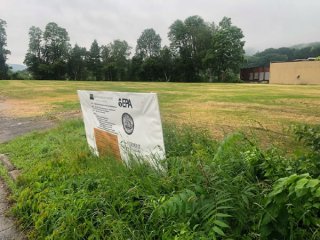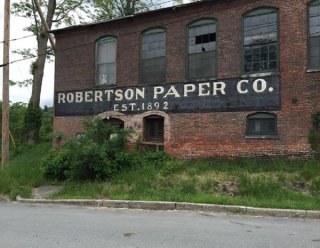R1 Success Story: Robertson Paper Mill, Bellows Falls, Vt.
EPA Grant Recipient:
Bellows Falls ADC
Grant Types:
Multipurpose, Revolving Loan Fund
Former Uses:
paper factory and machine shop
Current Use:
awaiting commercial redevelopment
Download Success Story:
Robertson Paper Mill Bellows Falls, Vt. (pdf)
The redevelopment of this former paper company in Bellows Falls is a model for how construction and demolition can be done to save money and the environment. Robertson Paper Company operated from the early 1900s to the mid 1980s as one of the largest producers of waxed paper in the U.S. Robbie Paper, as it was known locally, was demolished in the spring of 2019 to make way for redevelopment of "The Island," a 30‐acre tract tucked between the Bellows Falls Canal to the west and the Connecticut River to the east. The project site was taken on by the Bellows Falls Area Development Corporation in 2013, which planned to clean and redevelop the site for commercial uses. The redevelopment is being funded with federal, state and local support, including grants from the Environmental Protection Agency's Brownfields Assessment and Cleanup Program.
Lead, arsenic, asbestos, petroleum and polycyclic aromatic hydrocarbons were found in the soil and building materials at Robbie Paper during a site investigation funded by the Windham Regional Commission, using their Brownfields assessment grant. EPA also directly performed a second site assessment focused on the underground petroleum contamination under its Targeted Brownfields Assessment technical assistance program. The cleanup involved demolishing a building, removing asbestos, excavating contaminated soil, and installing 18 inches of clean soil to contain any contaminated soil remaining. A local demolition and salvage contractor was able to save much of the debris. Salvaging brick, timbers, metals, and architectural granite protected the environment and cost developers less than sending the waste to a landfill. Advanced planning made it possible to reclaim materials and respect historic preservation. Salvaged items, like decorative granite lintels, iron framing supports, and original boiler parts, will be re-used or displayed in a kiosk depicting the history of the Island.

Utilizing Sustainable Materials Management to reclaim and salvage building materials
The success of this project's sustainability goals was enhanced by the partnership between EPA's Sustainable Materials Management program and the Vermont Department of Environmental Conservation. Vermont has laws and policies such as Act 250, Vermont's land use and development law, which provides a public process for reviewing and managing the environmental, social and fiscal consequences of major subdivisions and developments. The law ensures that larger developments complement Vermont's unique landscape, economy and community needs. It requires that applicants involved in more than 5,000 square feet of construction or demolition have a plan that strives to find new uses for asphalt shingles, scrap metal, dry wall, plywood, engineered wood, brick, concrete, granite, slate, and other construction materials and debris. In addition, clean wood is banned from landfills, a law passed in Vermont in 2016. DEC provides technical assistance and market research to Vermont construction and demolition businesses. This project did not trip the need for an Act 250 permit, but nevertheless worked with the state on a construction waste management plan.
Materials that were salvaged from Robbie Paper include the following:
| Materials | Destination | Amount |
|---|---|---|
| Metals | Scrap Recycling | 10 tons |
| Timbers | Denailed and sold for reuse/milling | 25,580 board feet |
| Bricks | Salvaged and sold | 1000 cubic yards |
| Left Over Paper | Recycled | 100 tons |
| Interior Building Contents | miscellaneous – doors, windows, lights, fixtures, etc. | All donated |
| Contaminated Soils (polyaromatic hydrocarbons (PAH) and arsenic) | soils encapsulated on site rather than being disposed of in landfill | 1,600 cubic yards |
"With the help of the EPA and our other funding partners, we were able to take our project from conceptual phase to reality. The site had an historically significant building that had fallen to ruin through decades of neglect when we purchased it. Although the building had to be demolished for public safety and turned out to be a Brownfield site, we now have a 1.67-acre parcel to be developed for commercial purposes, which will bring employment and opportunities to our community."
Robin Sweetapple
President, BFADC
Today

The site, located in the heart of downtown, is now ready for redevelopment and to shepherd in the next phase of the Island's history.
EPA Grant Recipients: Windham Regional Commission, Vermont DEC, Vermont Agency of Commerce and Community Development, Island Holdings LLC (subsidiary of Bellows Falls Area Development Corp).
Funding
The Environmental Protection Agency has invested over $700,000 in Brownfields funding at this site for assessment and cleanup as follows:
Assessment ($234,000)
- Vermont DEC ($10,334)
- Windham Regional Commission ($93,608)
- EPA TBA technical assistance ($130,000)
Cleanup ($501,137)
- Vermont Agency of Commerce and Community Development Revolving Loan Fund ($151,137)
- Windham Regional Commission Revolving Loan Fund ($150,000)
- Direct cleanup grant to Island Holdings LLC ($200,000)
Other funding sources which contributed to the project included $150,000 from ACCD's Community Development Block Grant Program for demolition and $300,000 from the Windham County Economic Development Program and $140,000 from the Town of Rockingham's Revolving Loan Fund for project management, planning, and other expenses.
For more information:
Visit the EPA Brownfields website at www.epa.gov/brownfields or contact Frank Gardner, 617-918-1278, gardner.frank@epa.gov.
EPA 560-F-19-185
September 2019
